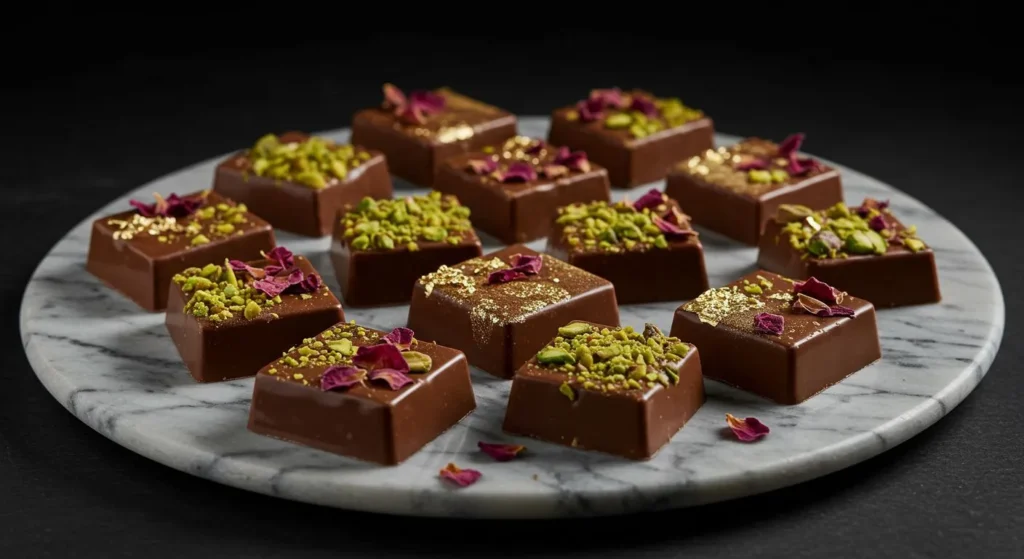
Table of Contents
Introduction to Dubai’s Luxury Chocolate Culture
Dubai has emerged as a global hub for luxury culinary experiences, with its chocolate creations standing at the forefront of this gastronomic revolution. The fusion of traditional Middle Eastern flavors with premium chocolate has created a distinctive niche that captures the essence of Dubai’s opulence. This royal-style chocolate confection featuring qatayef and pistachio paste represents the pinnacle of this culinary art form, offering an unforgettable taste experience that bridges Eastern and Western flavor profiles.
The luxury chocolate industry in Dubai has witnessed tremendous growth over the past decade, with artisanal chocolatiers establishing boutiques in prestigious locations such as Dubai Mall, Mall of the Emirates, and along Jumeirah Beach Road. These establishments have redefined chocolate craftsmanship by incorporating local ingredients and traditional Middle Eastern dessert elements into their creations, creating signature pieces that cannot be found anywhere else in the world.
This particular recipe combines the rich, velvety texture of premium chocolate with the distinctive sweetness of qatayef (a traditional Arab pastry especially popular during Ramadan) and the nutty complexity of pistachio paste. The result is a multi-layered confection that embodies Dubai’s commitment to luxury, innovation, and cultural fusion.
History of Chocolate in Middle Eastern Cuisine
While chocolate doesn’t have deep historical roots in traditional Middle Eastern cuisine, the region’s relationship with sweet confections dates back centuries. The introduction of chocolate to the Middle East is relatively recent, but it has been embraced with the same passion and creativity that characterizes the region’s approach to culinary arts.
What makes Dubai’s chocolate scene unique is its willingness to experiment with local flavors and ingredients. Pistachios, dates, saffron, cardamom, and rose water – staples of Middle Eastern desserts – have been expertly incorporated into chocolate creations, resulting in distinctive flavor profiles that can’t be replicated elsewhere.
The combination of qatayef and chocolate is a particularly innovative pairing. Qatayef, a sweet dumpling typically filled with cream or nuts, has been a beloved dessert throughout the Arab world for generations. By incorporating elements of qatayef into luxury chocolate, Dubai’s chocolatiers have created a bridge between traditional and modern dessert concepts.
The Royal Connection: Why This Chocolate is Fit for Royalty
The designation “Royal Style” for this chocolate creation is not merely marketing hyperbole. Dubai’s royal family, the Al Maktoum family, has been instrumental in establishing the emirate as a luxury destination, and the standards for any product deemed “royal” must meet exceptional quality benchmarks.
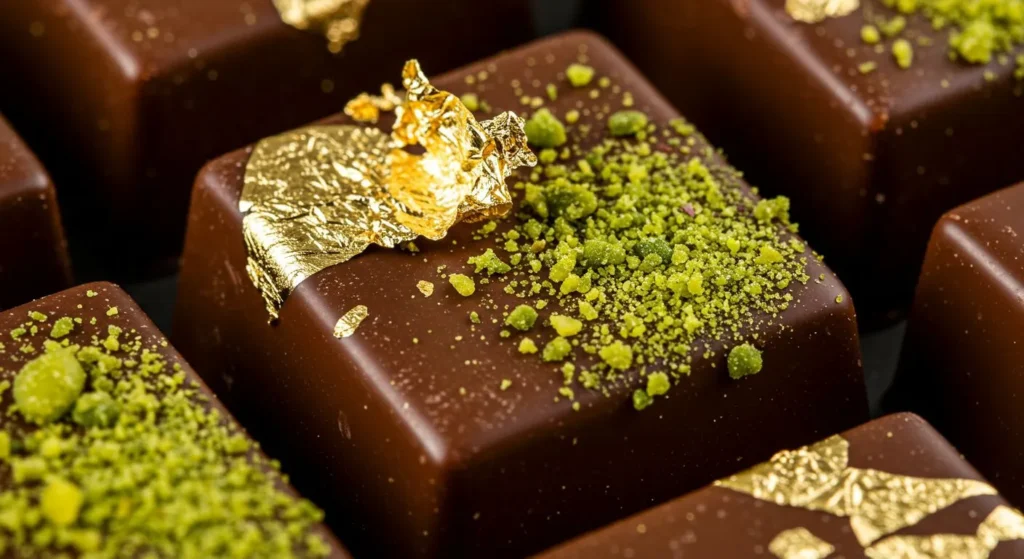
Several factors contribute to the royal status of this chocolate:
- Premium Ingredients: Only the finest chocolate couverture (typically with a minimum of 70% cocoa solids), Iranian pistachios (considered among the world’s best), and artisanal qatayef prepared by master pastry chefs are used.
- Meticulous Craftsmanship: The preparation involves precise temperature control for tempering the chocolate, careful layering of components, and hand-finishing techniques that require years of training to master.
- Presentation Excellence: The final product is often adorned with edible gold leaf, a signature decorative element in Dubai’s luxury desserts that references the emirate’s heritage in gold trading.
- Exclusive Distribution: These chocolates are typically available only at five-star hotels, high-end boutiques, or by special order for diplomatic events and royal gatherings.
The combination of these elements creates a chocolate experience that goes beyond mere confectionery to become a statement of cultural sophistication and luxury craftsmanship.
Essential Ingredients for Luxury Dubai Chocolate
To create this exquisite chocolate confection, you’ll need to source premium ingredients. While substitutions can be made, the authentic luxury experience requires specific components:
For the Chocolate Base:
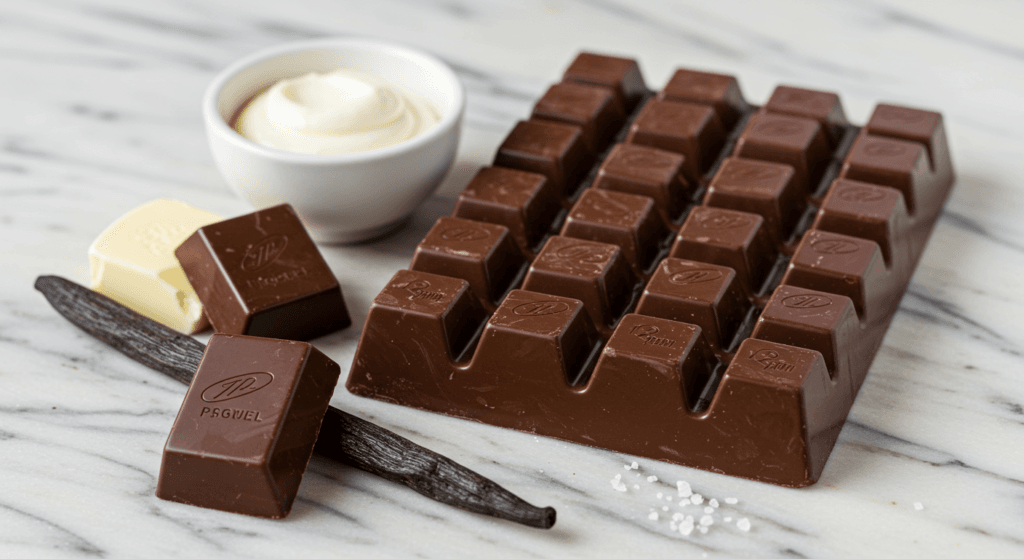
- 1 pound (450g) premium dark chocolate couverture (70% cocoa minimum)
- 1/2 pound (225g) premium milk chocolate couverture (40% cocoa minimum)
- 1/4 cup (60ml) heavy cream
- 2 tablespoons (30ml) unsalted butter
- 1 teaspoon vanilla bean paste (not extract)
- 1/4 teaspoon sea salt
For the Qatayef Element:
- 6 small qatayef pancakes (can be purchased from Middle Eastern grocery stores or made from scratch)
- 1/4 cup (60ml) orange blossom water
- 2 tablespoons honey (preferably Middle Eastern varieties like Sidr)
- 1/4 cup (40g) finely chopped dates (Medjool preferred)
For the Pistachio Paste:
- 2 cups (250g) raw, unsalted pistachios (Iranian variety preferred)
- 3 tablespoons (45ml) rosewater
- 1/4 cup (50g) fine sugar
- 2 tablespoons (30ml) neutral oil (grapeseed or sunflower)
For Decoration:
- 1/4 cup (30g) crushed pistachios
- 2 sheets edible gold leaf
- 1 tablespoon dried rose petals
- 1 teaspoon ground cardamom
Special Equipment:
- Chocolate thermometer
- Silicone molds (preferably in geometric Arabian patterns)
- Parchment paper
- Pastry brush
- Food processor
- Double boiler or bain-marie setup
The quality of these ingredients directly impacts the final result. Authentic pistachios from Iran have a distinctive brightness and depth of flavor that domestic varieties may lack. Similarly, orange blossom water and rosewater should be culinary-grade products rather than cosmetic versions, which can contain additives unsuitable for consumption.
Preparing the Pistachio Paste
The pistachio paste forms the heart of this confection, providing a rich, nutty foundation that complements the sweetness of the chocolate. Creating it from scratch ensures the freshest flavor and proper texture:
- Toast the Pistachios: Preheat your oven to 325°F (165°C). Spread the pistachios on a baking sheet in a single layer and toast for 8-10 minutes until fragrant but not browned. Allow to cool completely.
- Remove Skins: Rub the pistachios between your hands or in a clean kitchen towel to remove as many of the papery skins as possible. This step is crucial for achieving the vibrant green color associated with luxury pistachio paste.
- Initial Processing: Place the skinned pistachios in a food processor and pulse until coarsely ground.
- Create the Paste: Add the sugar and continue processing. Gradually drizzle in the oil while the machine is running until the mixture begins to form a paste.
- Add Aromatics: Pour in the rosewater and process until the paste reaches a smooth, spreadable consistency similar to natural peanut butter. This typically takes 3-5 minutes of continuous processing.
- Rest the Paste: Transfer the pistachio paste to an airtight container and refrigerate for at least 4 hours, preferably overnight. This resting period allows the flavors to meld and the texture to stabilize.
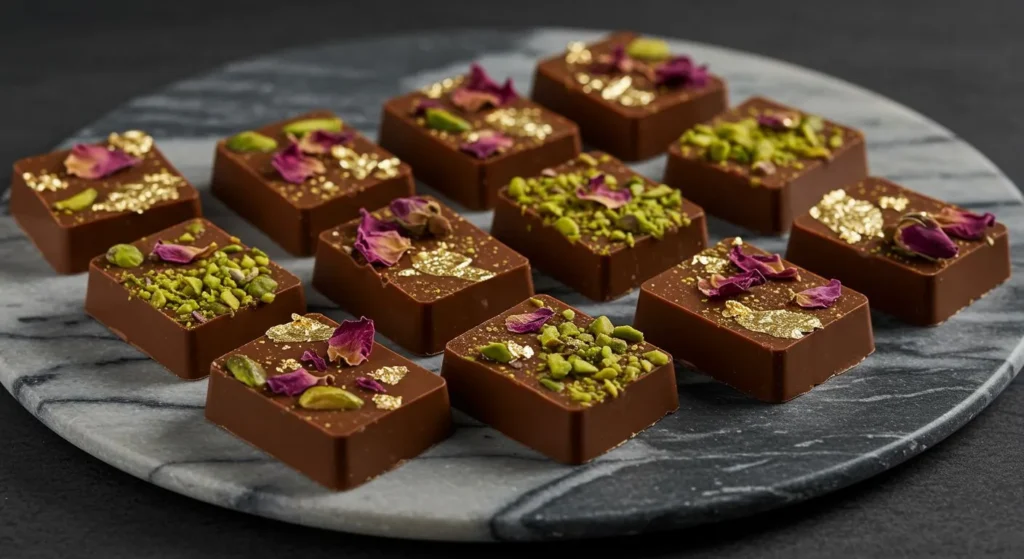
The finished paste should have a vibrant green color, smooth texture, and intense pistachio flavor with subtle floral notes from the rosewater. If the paste seems too thick, you can adjust the consistency by adding a small amount of additional oil.
Preparing the Qatayef Component
The qatayef element adds textural contrast and a distinctive Middle Eastern character to the chocolate:
- Prepare the Syrup: In a small saucepan, combine the orange blossom water and honey. Warm over low heat until fully integrated, then remove from heat and allow to cool.
- Prepare the Qatayef: If using store-bought qatayef, ensure they’re fresh. If making from scratch, prepare the pancakes according to your recipe but do not fill or fold them.
- Infuse the Qatayef: Brush each qatayef pancake generously with the orange blossom honey syrup on both sides, allowing the liquid to fully absorb.
- Add the Dates: Sprinkle the finely chopped dates evenly over the qatayef pancakes.
- Crisp the Qatayef: Arrange the pancakes on a baking sheet and place in a 300°F (150°C) oven for 10-12 minutes until slightly crisp but not browned.
- Process into Crumbs: Once cool, break the qatayef into pieces and pulse in a food processor until you have a mixture of fine crumbs and small chunks for textural variety.
This qatayef preparation strikes a balance between preserving the traditional flavor profile while adapting the form to work within a chocolate confection.
Tempering the Chocolate
Proper tempering is essential for professional-quality chocolate with a perfect shine, snap, and mouthfeel:
- Prepare Your Workspace: Ensure all tools are completely dry, as even a drop of water can cause chocolate to seize. Have a chocolate thermometer ready.
- Chop the Chocolate: Finely chop all chocolate to ensure even melting.
- Melt the Dark Chocolate: Place 2/3 of the dark chocolate in a heat-proof bowl over simmering water (double boiler method), ensuring the bowl doesn’t touch the water. Stir gently until melted, reaching 115°F (46°C) for dark chocolate.
- Seed the Chocolate: Remove from heat and add the remaining 1/3 of chopped dark chocolate. Stir continuously until the temperature drops to 84°F (29°C).
- Reheat Slightly: Place the bowl back over warm (not hot) water briefly to raise the temperature to 88-90°F (31-32°C) for dark chocolate. This is the working temperature.
- Test the Temper: Dip a knife tip in the chocolate and let it set at room temperature for 3-5 minutes. Properly tempered chocolate will be firm, glossy, and not streaky.
- Repeat for Milk Chocolate: Follow the same process for the milk chocolate, with different temperature targets: melt to 110°F (43°C), cool to 80°F (27°C), then reheat to 86-88°F (30-31°C).
Maintain the working temperature throughout the assembly process, using brief reheating periods if necessary. Working with tempered chocolate requires focus and precision, but the results are worth the effort.
Creating the Ganache Center
The ganache provides a silky, melt-in-your-mouth center that carries the aromatic flavors:
- Heat the Cream: In a small saucepan, bring the heavy cream just to a simmer (do not boil).
- Make the Ganache Base: Pour the hot cream over 1/3 of the tempered dark chocolate in a separate bowl. Add the butter and allow to sit for 30 seconds.
- Emulsify: Stir from the center outward until smooth and glossy. Add the vanilla bean paste and sea salt, stirring to combine.
- Incorporate Flavors: Fold in 2 tablespoons of the pistachio paste and 3 tablespoons of the qatayef crumb mixture, stirring gently to maintain air in the ganache.
- Set Aside: Cover the surface directly with plastic wrap and set aside at room temperature while preparing the molds.
The ganache should be used while still pliable but not runny. If it firms up too much, it can be gently rewarmed over a double boiler.
Assembly and Decoration
This multi-step assembly process creates the distinctive layered effect of luxury Dubai chocolate:
- Prepare the Molds: Ensure silicon molds are completely clean and dry. If using geometric molds, brush a small amount of edible gold dust into the patterns (optional).
- Create the Shell: Using a pastry brush, coat the inside of each mold with tempered dark chocolate. Ensure the coating is thick enough to create a stable shell but thin enough to leave room for fillings. Refrigerate for 5 minutes to set.
- Add Pistachio Layer: Spread a thin layer of pistachio paste at the bottom of each chocolate shell. Refrigerate for 3 minutes to firm up.
- Add Qatayef Layer: Sprinkle a layer of the qatayef crumb mixture over the pistachio paste, pressing gently to adhere.
- Fill with Ganache: Pipe or spoon the ganache into each mold, filling to about 3/4 capacity. Tap the mold gently to eliminate air bubbles.
- Seal the Chocolates: Cover each filled mold with tempered milk chocolate, using an offset spatula to create a smooth, flat bottom. Refrigerate for 15-20 minutes until completely set.
- Unmold: Carefully flex the silicon molds to release the chocolates. Handle with gloved hands to avoid fingerprints on the finished surface.
- Final Decoration: Using tweezers, apply small pieces of gold leaf to each chocolate. Sprinkle with a combination of crushed pistachios, cardamom, and rose petals while the surface is still slightly tacky from handling.
- Set: Allow the decorated chocolates to set at room temperature for at least 1 hour before serving or packaging.
The finished chocolates should have clearly defined layers visible when bitten or cut, showcasing the artistic craftsmanship that goes into their creation.
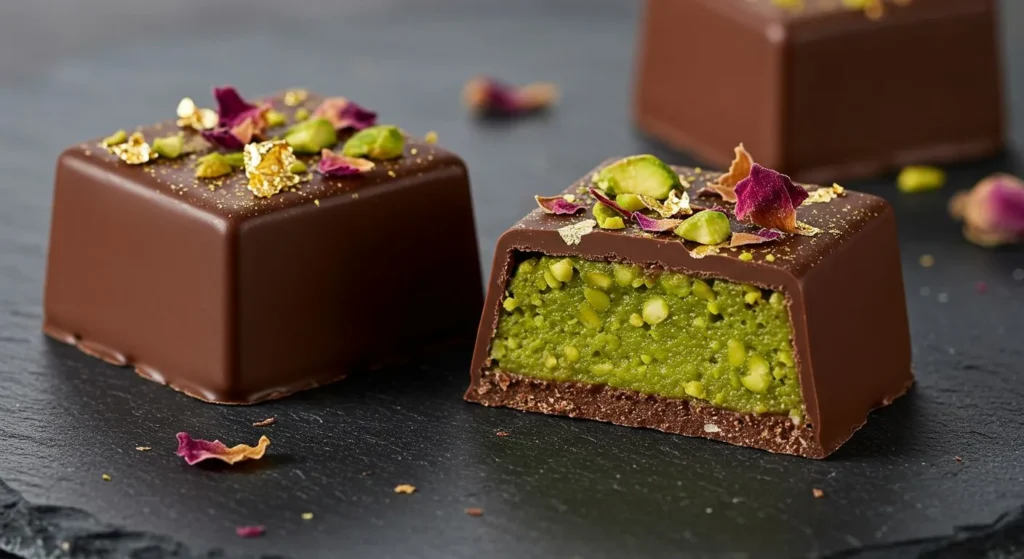
Presentation and Storage
Proper presentation and storage are crucial for maintaining the quality and visual impact of these luxury chocolates:
Presentation:
- Arrange the chocolates on a dark slate or marble platter for formal service
- Use individual gold foil cups for each piece when including in a gift box
- Accompany with small cups of Arabic coffee or mint tea for the complete experience
- For special occasions, create a display with dried rose petals, whole pistachios, and cinnamon sticks
Storage:
- Store the chocolates in an airtight container at 60-65°F (15-18°C)
- Keep away from direct sunlight or strong odors
- Do not refrigerate after final assembly, as condensation upon removal can damage the finish
- Consume within 10-14 days for optimal flavor and texture
- If gifting, include storage instructions with your presentation
When properly stored, these chocolates maintain their visual splendor and flavor complexity for the full shelf life, though the textural contrasts are most pronounced in the first week after creation.
The Taste Experience
What makes this luxury Dubai chocolate truly unforgettable is the orchestrated progression of flavors and textures as it melts in the mouth:
- The First Impression: The initial snap of the tempered chocolate shell provides a satisfying tactile experience and releases the first notes of rich, complex cocoa.
- The Middle Notes: As the outer shell begins to melt, the ganache delivers a silky mouthfeel with subtle hints of vanilla and salt that enhance the chocolate without overwhelming it.
- The Distinctive Elements: The encounter with pistachio paste brings a nutty richness and slight chewiness, while the qatayef crumbs provide textural contrast and introduce the aromatic notes of orange blossom and honey.
- The Finish: The experience concludes with the delicate floral notes of rosewater and cardamom, creating a lingering finish that continues to evolve even after the chocolate has fully melted.
This progression of flavors represents the culinary philosophy behind Dubai’s luxury chocolate scene: respectful of traditional flavor combinations while presenting them in innovative, technically sophisticated forms.
Cultural Significance and Serving Occasions
In Dubai’s social calendar, these luxury chocolates have found their place at specific occasions where they serve both culinary and cultural functions:
Formal Occasions:
- Eid celebrations, particularly Eid al-Fitr following Ramadan
- Wedding receptions and engagement parties
- Business gifting, especially in negotiations with international partners
- Diplomatic functions where showcasing Emirati culinary innovation is desired
Serving Rituals:
- Traditional service includes passing the chocolates after the main course but before coffee
- When served with coffee, the chocolate should be tasted first, then followed by a sip of coffee
- In more formal settings, the chocolates may be presented on individual plates with small gold forks
- A brief explanation of the components is customary when serving to guests unfamiliar with Middle Eastern flavors
This chocolate creation represents more than just a dessert; it embodies Dubai’s cultural narrative of honoring tradition while embracing innovation and luxury.
Adapting the Recipe for American Home Kitchens
While the authentic luxury Dubai chocolate experience requires specialized ingredients and equipment, home cooks in America can create a respectable adaptation:
Ingredient Substitutions:
- If Iranian pistachios are unavailable, California pistachios can be substituted
- Orange flower water can be found in many specialty food stores or online
- Pre-made qatayef can be replaced with thin pancakes brushed with honey and orange zest
- Instead of edible gold leaf, use gold luster dust available in cake decorating sections
Simplified Methods:
- Instead of molded chocolates, create a layered bark by spreading tempered chocolate on parchment, topping with the fillings, and covering with another layer of chocolate
- If tempering chocolate seems daunting, use good quality melting wafers designed to set without tempering
- Create a deconstructed version by serving a scoop of chocolate ganache alongside pistachio-studded qatayef crisps
The key is preserving the essential flavor combination of chocolate, pistachio, and qatayef, even if the presentation differs from the Dubai original.
 DINNER
DINNER  LUNCH
LUNCH 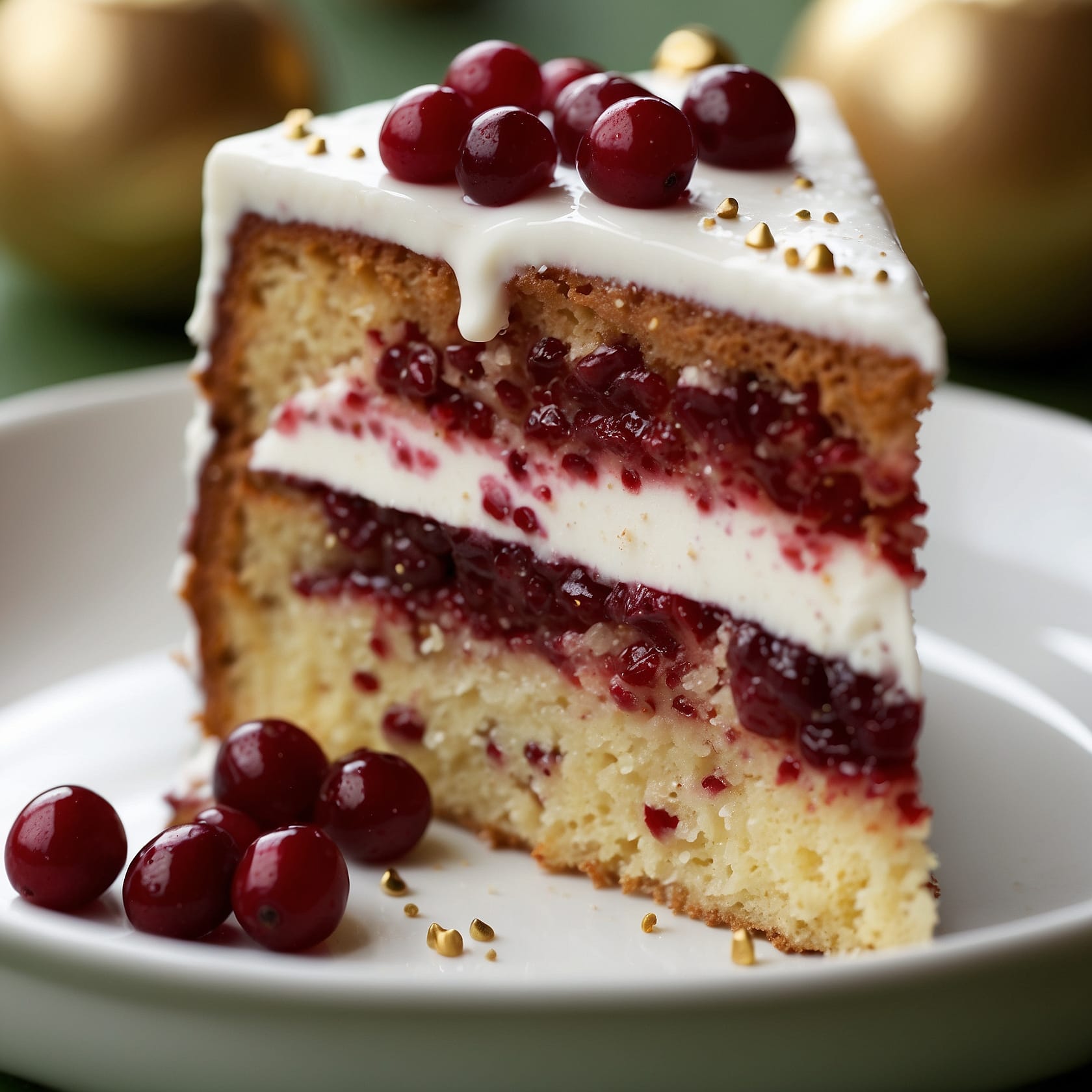 CAKE
CAKE  BREAKFAST
BREAKFAST For more amazing recipes, be sure to check out our other sections to explore a variety of ideas that will enrich your cooking experience. Each section offers its own unique flavors to ensure a delightful culinary journey:
- Easy and Quick Recipes: A collection of dishes that guarantee delicious meals with minimal effort and time.
- Healthy Recipes: Discover healthy and delicious options that fit your lifestyle.
- Desserts: A diverse selection of sweets that will add a special touch of sweetness to your table.
- Lunch Recipes: Tasty lunch ideas that you can easily prepare to delight your family.
- Dinner Recipes: Delicious and easy-to-make recipes that will make your dinner a memorable occasion.
Conclusion: The Future of Dubai’s Luxury Chocolate Traditions
As Dubai continues to establish itself as a global culinary destination, its unique approach to chocolate craftsmanship represents a fascinating case study in cultural fusion and luxury positioning. The traditional flavors of the Middle East—pistachios, dates, rose, and orange blossom—have found new expression through the medium of premium chocolate, creating distinctive confections that could only have emerged from this particular cultural context.
This royal-style chocolate with qatayef and pistachio paste stands as a testament to Dubai’s ongoing culinary evolution. It honors traditional flavor combinations while elevating them through technical precision and luxury presentation. For chocolate enthusiasts around the world, these creations offer not just an indulgent treat but a taste of Dubai’s ambition to create distinctive, world-class culinary experiences.
Whether experienced in a five-star hotel in Dubai itself or recreated in an American kitchen, this unforgettable chocolate confection bridges cultural traditions and creates a moment of shared appreciation for craftsmanship and flavor—truly a royal experience accessible through the universal language of chocolate.
